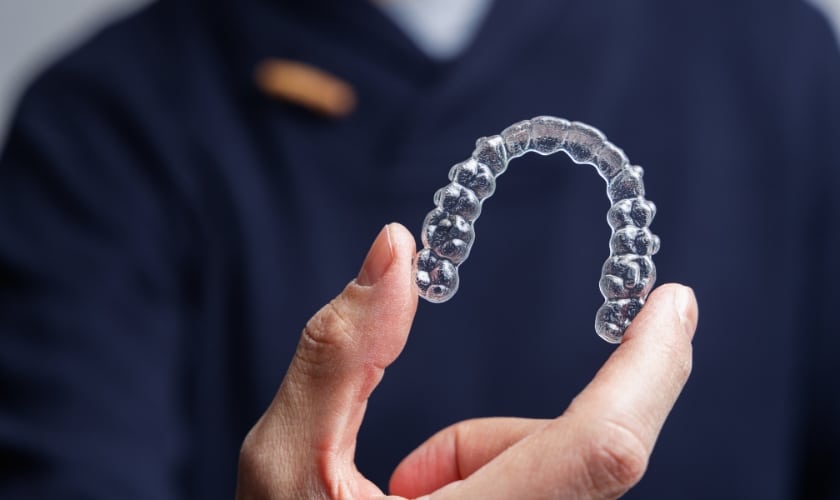Are you dreaming of a straighter and more confident smile? Well, the good news is that you have options! Invisalign and traditional braces are two popular orthodontic treatments that can help you achieve the results you desire. But when it comes to selecting the best option for yourself, there’s no one-size-fits-all answer. That’s why we’re here today – to dive into the world of teeth-straightening techniques and compare Invisalign in Airdrie versus traditional braces in order to find out which one suits your unique needs, lifestyle, and goals. So, let’s dive in.
Understanding Invisalign: The Clear Advantage
Invisalign, a revolutionary orthodontic solution, relies on a series of custom-made, clear aligners to gradually shift teeth into place. These aligners are not only virtually invisible but also removable, providing unparalleled convenience in maintaining oral hygiene. With Invisalign, you can enjoy the freedom to eat your favorite foods without restrictions, making it an appealing choice for those seeking a discreet and adaptable orthodontic option.
Traditional Braces: Time-Tested Effectiveness
Traditional braces, consisting of brackets, wires, and bands, have stood the test of time as a highly effective method for correcting misalignments. While their appearance may be more noticeable, especially in the early stages, modern braces now come in various materials, including tooth-colored options, for a less conspicuous look. Traditional braces excel in addressing severe misalignments and complex orthodontic issues, offering a reliable and proven approach to achieving a straighter smile.
The Treatment Process: Invisalign vs. Traditional Braces
During Invisalign treatment in Airdrie, a series of aligners are worn for approximately two weeks each before moving on to the next set. Regular check-ups with your orthodontist ensure the aligners are effectively guiding your teeth into their desired positions.
On the other hand, traditional braces require periodic adjustments to tighten the wires, gradually moving the teeth. Both approaches demand commitment to regular appointments, emphasizing the importance of patient compliance for successful outcomes.
Comfort and Maintenance: A Closer Look
Invisalign aligners are known for their smooth, comfortable fit, causing minimal irritation to the mouth. Their removable nature simplifies oral care, allowing for easy brushing and flossing.
Traditional braces, while effective, may initially cause discomfort as the mouth adjusts to the hardware. They require extra diligence in cleaning to prevent plaque buildup around brackets and wires. Understanding the nuances of comfort and maintenance is crucial for individuals considering either option to align their teeth.
Aesthetic Considerations: Balancing Visibility and Discretion
In the realm of aesthetics, Invisalign takes the lead by offering a nearly invisible solution. The clear aligners blend seamlessly with the natural color of your teeth, providing a discreet orthodontic experience.
Traditional braces, although available in more inconspicuous materials, are still visible. However, many embrace this visibility as a chance to showcase colorful bands or customized bracket designs, turning their orthodontic journey into a personalized and expressive experience.
Financial Aspects: Weighing the Investment
The cost of orthodontic treatment is a crucial consideration. Invisalign, often perceived as a premium option, may come with a higher initial price tag. However, factors such as insurance coverage and the complexity of the case can influence the overall cost.
Traditional braces, while generally more budget-friendly, also vary in cost based on the type of braces chosen and the duration of treatment. Understanding the financial aspects allows individuals to make an informed decision aligned with their budget and orthodontic needs.
Lifestyle and Treatment Compatibility
Invisalign aligners offer the flexibility of removal, granting individuals the freedom to enjoy their favorite foods without constraints. This removable aspect also simplifies activities like playing musical instruments or engaging in contact sports.
Traditional braces, while robust and effective, necessitate some lifestyle adjustments to avoid damage. Understanding how each option aligns with your daily life and activities ensures a harmonious integration of orthodontic treatment into your routine.
Choosing the Right Option for You
Choosing between Invisalign and traditional braces boils down to your lifestyle and orthodontic needs. If you prioritize an inconspicuous option with the flexibility to remove your orthodontic device, Invisalign might be ideal. However, for those seeking a proven method with less day-to-day responsibility, traditional braces could be the better choice. Additionally, the complexity of your orthodontic issues plays a role; while Invisalign suits many cases, severe misalignments might benefit more from traditional braces. The ultimate decision is best made in consultation with an orthodontist for Invisalign in Airdrie, who will consider your oral health, preferences, and lifestyle to recommend the most suitable option for your desired smile.


